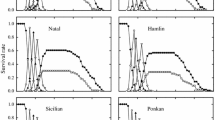Abstract
The present study was developed to evaluate the resistance of the following genotypes of Citrus and related genera to this pest: ‘Pera,’ ‘Natal’, and ‘Washington Navel’ oranges (Citrus sinensis), ‘Marsh Seedless’ grapefruit (Citrus paradisi), hardy orange ‘Rubidoux’ (Poncirus trifoliata), kumquat (Fortunella margarita Swingle), citrumelo ‘Swingle’ (C. paradisi x P. trifoliata), and citrange ‘Troyer’ (P. trifoliata x C. sinensis). The experiments were performed in greenhouses with plants grafted onto ‘Rangpur’ lime (Citrus limonia) and placed individually in voile cages. The preference for oviposition in a no-choice test, and the effect of genotype were evaluated. The egg-adult cycle was monitored to determine the effect of genotype on the biology of the insect. Poncirus ‘Rubidoux’ was the least preferred genotype for oviposition; reduced number of eggs was also found to occur on citrange ‘Troyer’, and ‘Marsh Seedless’ was the genotype with the most eggs. No significant variation in the duration of the embryonic period was observed; however, a difference in the viability of eggs was found, with the lowest egg viabilities on ‘Swingle.’ Kumquat and ‘Marsh Seedless’ genotypes were correlated with increased durations of the nymphal phase, however, there was no difference in the survival of this phase. Fecundity of females on ‘Troyer’, ‘Swingle’, and kumquat was reduced. Considering all of the evaluated parameters, it was concluded that cultivars of sweet orange are the most susceptible genotypes to Diaphorina citri. Regarding oviposition, P. trifoliata ‘Rubidoux’ showed resistance of the antixenosis type.

Similar content being viewed by others
References
Aubert B (1987) Trioza erytreae Del Guercio and Diaphorina citri Kuwayama (Homoptera: Psylloidea), the two vectors of citrus greening disease: biological aspects and possible control strategies. Fruits 42:149–162
Chakravarthi VP, Savithri P, Prasad PR, Naidu VG, Reddy PP, Kumar NKK, Verghese A (1998) Relative susceptibility of citrus germplasm to citrus psylla, Diaphorina citri Kuwayama (Homoptera: Psyllidae), pp. 30–31 In: Proc. First Natl. Symp. Pest Management in Horticultural Crops: Environmental Implications and Thrusts, Bangalore, India.
Coletta-Filho HD, Takita MA, Targon MLPN, Machado MA (2005) Analysis of the 16S rDNA sequences from citrus-Huanglongbing bacteria reveal a different “Ca. Liberibacter” strain associated to the citrus disease in São Paulo, Brazil. Plant Dis 89(8):848–852
Coletta-Filho HD, Targon MLPN, Takita MA, De Negri JD, Pompeu J Jr, Machado MA, Amaral AM, Muller GW (2004) First report of the causal agent of Huanglongbing (“Candidatus liberibacter asiaticus”) in Brazil. Plant Dis 88(12):1382
Costa Lima AM (1942). Insetos do Brasil. Tomo 3°, Homópteros. Escola Nacional de Agronomia, Ministério da Agricultura, Rio de Janeiro.
Da Graça JV (1991) Citrus greening disease. Annu Rev Phytopathol 29:109–136
Étiennea J, Quilicib S, Marivala D, Franck A (2001) Biological control of Diaphorina citri (Hemiptera: Psyllidae) in Guadeloupe by imported Tamarixia radiata (Hymenoptera: Eulophidae). Fruits 56:307–315
Hall DG, Sétamou M, Mizell RF (2010) A comparison of sticky traps for monitoring Asian citrus psyllid (Diaphorina citri Kuwayama). Crop Prot 29:1341–1346
Ikeda K, Ashihara W (2008) Preference of adult Asian citrus psyllid, Diaphorina citri (Homoptera: Psyllidae) for Murraya paniculata and Citrus unshiu. Jpn J Appl Entomol Zool 52:27–30
Liu HY, Tsai JH (2000) Effects of temperature on biology and life table parameters of the Asian citrus psyllid, Diaphorina citri Kuwayama (Homoptera: Psyllidae). Ann Appl Biol 137:201–201
Martinez AL, Wallace JM (1967) Citrus leaf mottle-yellows disease in the Philippines and transmission of the causal virus by a psyllid, Diaphorina citri. Plant Dis Rep 58:692–695
McKenzie CL, Puterka GJ (2004) Effect of sucrose octanate on survival of nymphal and adult Diaphorina citri (Homoptera: Psyllidae). J Econ Entomol 97:970–975
Mead FW (2002) Asiatic citrus psyllid – Diaphorina citri Kuwayama. 2002. Available at: <http://edis.ifas.ufl.edu/pdffiles/IN/IN16000.pdf>, accessed 08 Dec. 2008
Michaud JP, Olsen LE (2004) Suitability of Asian citrus psyllid, Diaphorina citri, as prey for ladybeetles. BioControl 49:417–431
Nava DE, Torres ML, Rodrigues GMDL, Bento JMS, Parra JRP (2007) Biology of Diaphorina citri (Hem., Psyllidae) on different hosts and at different temperatures. J App Entomol 131:709–715
Parra JRP, Negri HNO, Pinto AS (2003) Guia ilustrado de pragas e insetos benéficos dos citros. AS Pinto
Richardson ML, Hall DG (2013) Resistance of Poncirus and Citrus x Poncirus germplasm to the Asian citrus psyllid. Crop Sci 53:183–188
Silva AGA, Gonçalves CR, Galvão DM, Gonçalves AJL, Gomes J, Silva MN, Simoni L (1968) Quarto catálogo dos insetos que vivem nas plantas do Brasil. Seus parasitos e predadores. Parte 2, tomo 1°, insetos, hospedeiros e inimigos naturais. Ministério da Agricultura, Rio de Janeiro.
Tsai JH, Liu YH (2000) Biology of Diaphorina citri (Homoptera: Psyllidae) on four host plants. J Econ Entomol 93:1721–1725
Westbrook CJ, Hall DG, Stover E, Duan YP, Lee RF (2011) Colonization of Citrus-related germplasm by Diaphorina citri (Hemiptera: Psyllidae). HortSci 46:997–1005
Yamamoto PT, Gravena S (2000) Espécies e abundância de cigarrinhas e psilídeos em pomares cítricos. Ann Soc Entomol Brasil 29:169–176
Acknowledgments
This study was supported in part by a grant from CNPq and FAPESP. José Djair Vendramim, André Luiz Lourenção, and Marcos Antonio Machado are fellows of CNPq.
Author information
Authors and Affiliations
Corresponding author
Additional information
Edited by Jorge B Torres – UFRPE
Rights and permissions
About this article
Cite this article
Borgoni, P.C., Vendramim, J.D., Lourencão, A.L. et al. Resistance of Citrus and Related Genera to Diaphorina citri Kuwayama (Hemiptera: Liviidae). Neotrop Entomol 43, 465–469 (2014). https://doi.org/10.1007/s13744-014-0230-0
Received:
Accepted:
Published:
Issue Date:
DOI: https://doi.org/10.1007/s13744-014-0230-0




